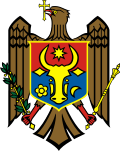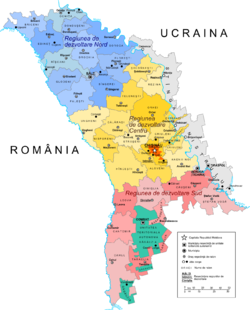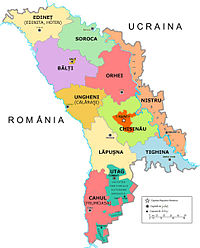- Administrative divisions of Moldova
-
Moldova 
This article is part of the series:
Politics and government of
MoldovaConstitutionParliamentJudiciaryExecutiveDivisionsElectionsForeign policy
Currently, Moldova is divided into 37 first-tier units,[1] including 32 districts (Romanian: raioane; see also raions):
three municipalities:
one autonomous territorial unit:
and one territorial unit:
The final status of the latter has not been settled yet, as the region, such as defined administratively, is not under the control of Moldovan authorities. The cities of Comrat and Tiraspol also have municipality status, but are not among first-tier units of Moldova; they are the seats of Gagauzia and Transnistria, respectively.
Contents
Localities
Moldova has a total of 982 incorporated localities (de jure with 982 mayors and 982 local councils), of which 5 have municipality status, 60 have city status, and 917 are villages with commune status. They cover the entire area of the country. Another 699 villages are too small to have a separate administration, and are part of either cities (40 of them) or communes (659). This makes for a total of 1,681 localities of Moldova, all but two of which are inhabited.
The status of Chişinău, Bălţi, and Bender as municipalities and first-level territorial units of the country allows their suburb villages to have, when large enough, their own mayor and local council. By contrast, the villages that are administratively part of (some of) the other cities do not retain self-rule.
- Districts 32:
Name of district District seat Area
(km²)Population (2011) Population
densityTowns/
villagesAnenii Noi Anenii Noi 892 83,100 93.2 45 Basarabeasca Basarabeasca 295 29,200 99.0 10 Briceni Briceni 814 75,300 92.5 39 Cahul Cahul 1,546 124,800 80.7 56 Cantemir Cantemir 870 62,800 72.2 51 Călărași Călărași 753 78,800 104.6 54 Căuşeni Căuşeni 1,163 92,300 79.3 48 Cimişlia Cimişlia 923 61,700 66.8 39 Criuleni Criuleni 688 73,100 106.2 43 Dondușeni Dondușeni 645 45,100 70.0 30 Drochia Drochia 1,000 90,100 90.1 40 Dubăsari Dubăsari 309 35,200 113.9 15 Edineţ Edineţ 933 82,900 88.9 49 Făleşti Făleşti 1,073 92,600 86.3 76 Floreşti Floreşti 1,108 90,000 81.2 74 Glodeni Glodeni 754 61,900 82.1 35 Hînceşti Hînceşti 1,484 122,000 82.2 63 Ialoveni Ialoveni 783 99,100 126.5 34 Leova Leova 775 53,800 69.4 39 Nisporeni Nisporeni 630 66,800 106.0 39 Ocniţa Ocniţa 597 56,100 94.0 33 Orhei Orhei 1,228 125,900 102.5 75 Rezina Rezina 621 52,600 84.7 41 Rîșcani Rîșcani 936 70,000 74.8 55 Sîngerei Sîngerei 1,033 93,400 90.4 70 Soroca Soroca 1,043 100,400 96.3 68 Străşeni Străşeni 730 91,300 125.1 39 Şoldăneşti Şoldăneşti 598 43,300 72.4 33 Ştefan Vodă Ştefan Vodă 998 71,900 72.0 26 Taraclia Taraclia 674 44,200 65.6 26 Telenești Telenești 849 74,200 87.4 54 Ungheni Ungheni 1,083 117,400 108.4 74 - Municipalities 3:
Name of municipalities Municipality Seat Area
(km²)Population (2011) Population
densityTowns/
villagesBălți Bălți 78 148,900 1909.0 3 Bender Bender 97 101,000 1041.2 2 Chişinău Chişinău 635 789,500 1243.3 35 - Autonomous territory 2:
Name of autonomy Autonomy Seat Area
(km²)Population (2011) Population
densityTowns/
villagesGăgăuzia Comrat 1,832 160,700 87.7 35 Transnistria Tiraspol 4,163 518,700 124.6 147 Notes
Areas not under central government control include:
- Transnistria, which with the exception of six communes (comprising a total of ten localities) corresponds to the geographic part of Moldova situated to the east of the Dniestr (Romanian: Nistru) river, is de jure a part of Moldova, but in fact is governed by breakaway authorities. (See also: War of Transnistria.) The city of Dubăsari (administratively in Transnistria, and not in the Dubăsari district), and these six communes (administratively in the Dubăsari district of Moldova, and not in the administrsative definition of Transnistria), all controlled by the central authorities (except the village of Roghi in commune Molovata Nouă, which is controlled by Tiraspol), form the northern part of the security zone set at the end of the war.
- Bender municipality (the city itself, and the commune Proteagailovca), and three communes (five localities) of Căuşeni district (Gîsca, Chiţcani, and Cremenciug) are de facto controlled by the breakaway regime of Transnistria. Together with one the commune Varniţa of Anenii Noi district and the commune Copanca of Căuşeni district under Moldovan control, these localities form the southern part of the security zone set at the end of the war. The city of Bender has both a Moldovan police force (mostly symbolic) and a Transnistrian militsiya force (practically in charge in most instances).
Population
- The smallest entity electing a mayor is commune Salcia, Taraclia district, population 441. It consists of the village Salcia, population 382, and the village Orehovca, population 59. The largest entity is themunicipality of Chişinău, electing a mayor for 712,218 inhabitants.
- The largest number of localities governed by a single commune or city government in Moldova is 6. This is the case for:
- city of Anenii Noi, population 11,463, of which 3,105 in the 5 suburban villages
- commune Copăceni, Sîngerei district, population 3,315
- commune Natalievca, Făleşti district, population 2,231
- commune Tătărăuca Veche, Soroca district, population 2,203
- On the opposite end, 41 of the 65 cities, and about half the communes of Moldova have local administration providing services for a single locality.
- There are four or five localities in Moldova with population zero:
- village Armanca, commune Vasileuţi, Rîşcani district
- village Chetrişul Nou, commune Chetriş, Făleşti district
- village Pelinia, loc. st. c. f., commune Pelinia, Drochia district
- village Stălineşti, commune Corestăuţi, Ocniţa district
- The village of Schinoasa was outlined within commune Ţibirica, Călăraşi district in 2007, and information is not available yet whether it has any population.
- Village (hamlet) Ivanovca, commune Natalievca, Făleşti district, population 19, inhabited by 14 Russians and 5 Ukrainians, is the only inhabited locality in Moldova without any ethnic Moldovans. On the opposite end, one commune, Cigârleni, Ialoveni district, population 2,411, and 42 villages of sub-commune level (population varying from 1 to 673), have 100% Moldovan population.
Coincident names
- There is a city Mărculeşti, and a different commune Mărculeşti, both situated in the Floreşti district
- There is a city Donduşeni, and a different commune Donduşeni, both situated in the Donduşeni district
- There is a city Drochia, and a different commune Drochia, both situated in the Drochia district
- There is a city Costeşti, Rîşcani district, population 2,247 (4,109 with 4 suburb villages), the 8th smallest city in Moldova, and a commune (village) Costeşti, Ialoveni district, population 11,128, the 2nd largest village in Moldova
- etc.
Previous divisions
Counties (1998-2003)
See also: Counties of MoldaviaBetween 1998 and February 2003, Moldova was divided into 12 territorial units, including 1 municipality, 1 autonomous territorial unit, 1 territorial unit, and 9 counties (Romanian: judeţe; seats in brackets):
- Chişinău municipality, surrounded by Chişinău county, but different from it
- Bălţi County (Bălţi)
- Cahul County (Cahul)
- Chişinău County (Chişinău)
- Edineţ County (Edineţ)
- Lăpuşna County (Hînceşti)
- Orhei County (Orhei)
- Soroca County (Soroca)
- Tighina County (Căuşeni)
- Ungheni County (Ungheni)
- Găgăuzia, autonomous territorial unit (Comrat)
- Stânga Nistrului, territorial unit (Dubăsari)
In 2003, just before the abolition of the county system, a Taraclia County was split out from the Cahul County; it coincides with the current Taraclia district.
Cities and districts (1991-1998)
Between 1991-1998, Moldova was divided into 10 cities and 40 districts[2]:
- Cities
- Districts
- Anenii Noi
- Basarabeasca
- Brinceni
- Cahul
- Camenca
- Cantemir
- Căinari
- Călăraşi
- Căuşeni
- Ciadîr-Lunga
- Cimişlia
- Comrat
- Criuleni
- Donduşeni
- Drochia
- Dubăsari
- Edineţ
- Făleşti
- Floreşti
- Glodeni
- Grigoriopol
- Hînceşti
- Ialoveni
- Leova
- Nisporeni
- Ocniţa
- Orhei
- Rezina
- Rîbniţa
- Rîşcani
- Sîngerei
- Slobozia
- Soroca
- Străşeni
- Şoldăneşti
- Ştefan Vodă
- Taraclia
- Teleneşti
- Ungheni
- Vulcăneşti
See also
- ISO 3166-2:MD, ISO subdivision codes for Moldova
References
External links
- Moldovan Ministry of Local Public Administration
- Law № 764-XV/2001 on the administrative organization of the Republic of Moldova available on Wikisource.
- Moldovan Law 431-XIII from April 19, 1995, Monitorul Oficial al Republicii Moldova, no. 31-32/340, June 9, 1995
 Administrative divisions of Moldova
Administrative divisions of MoldovaDistricts Anenii Noi · Basarabeasca · Briceni · Cahul · Cantemir · Călăraşi · Căuşeni · Cimişlia · Criuleni · Donduşeni · Drochia · Dubăsari · Edineţ · Făleşti · Floreşti · Glodeni · Hînceşti · Ialoveni · Leova · Nisporeni · Ocniţa · Orhei · Rezina · Rîşcani · Sîngerei · Soroca · Străşeni · Şoldăneşti · Ştefan Vodă · Taraclia · Teleneşti · Ungheni
Autonomous regions Municipalities 1 The political status of Transnistria is not settled. First-level administrative divisions in Europe Sovereign
statesAlbania · Andorra · Armenia2 · Austria · Azerbaijan3 · Belarus · Belgium · Bosnia and Herzegovina · Bulgaria · Croatia · Cyprus2 · Czech Republic · Denmark · Estonia · Finland · France1 · Georgia3 · Germany · Greece · Hungary · Iceland · Ireland · Italy · Kazakhstan2 · Latvia · Liechtenstein · Lithuania · Luxembourg · Republic of Macedonia · Malta · Moldova · Monaco · Montenegro · Netherlands · Norway · Poland · Portugal · Romania · Russia1 · San Marino · Serbia · Slovakia · Slovenia · Spain · Sweden · Switzerland · Turkey1 · Ukraine · United Kingdom
States with limited
recognitionAbkhazia3 · Kosovo · Northern Cyprus2 · South Ossetia3
1 Has part of its territory outside Europe. 2 Considered European for cultural, political and historical reasons but is geographically in West Asia. 3 Partially or entirely in Asia, depending on the definition of the border.Table of administrative country subdivisions by country Categories:- Subdivisions of Moldova
- Lists of country subdivisions
- Country subdivisions of Europe
- Moldova-related lists
Wikimedia Foundation. 2010.


